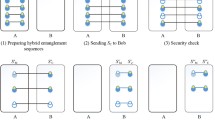Abstract
The quantitative security of quantum-noise randomized cipher (QNRC) in optically amplified links is analyzed from the perspective of physical-layer advantage. Establishing the wire-tap channel models for both key and data, we derive the general expressions of secrecy capacities for the key against ciphertext-only attack and known-plaintext attack, and that for the data, which serve as the basic performance metrics. Further, the maximal achievable secrecy rate of the system is proposed, under which secrecy of both the key and data is guaranteed. Based on the same framework, the secrecy capacities of various cases can be assessed and compared. The results indicate perfect secrecy is potentially achievable for data transmission, and an elementary principle of setting proper number of photons and bases is given to ensure the maximal data secrecy capacity. But the key security is asymptotically perfect, which tends to be the main constraint of systemic maximal secrecy rate. Moreover, by adopting cascaded optical amplification, QNRC can realize long-haul transmission with secure rate up to Gb/s, which is orders of magnitude higher than the perfect secrecy rates of other encryption systems.








Similar content being viewed by others
References
Bennett, C.H., Brassard, G.: Quantum cryptography: public key distribution and coin tossing. In: Proceedings on IEEE International Conference on Computers, Systems and Signal, Bangalore, India, pp. 175–179 (1984)
Scarani, V., Bechmann-Pasquinucci, H., Cerf, N.J., Dušek, M., Lütkenhaus, N., Peev, M.: The security of practical quantum key distribution. Rev. Mod. Phys. 81(3), 1301–1350 (2009)
Patel, K., Dynes, J., Lucamarini, M., Choi, I., Sharpe, A., Yuan, Z.L., Penty, R., Shields, A.: Quantum key distribution for 10 Gb/s dense wavelength division multiplexing networks. Appl. Phys. Lett. 104(5), 051123 (2014)
Barbosa, G., Corndorf, E., Kumar, P., Yuen, H.P.: Secure communication using mesoscopic coherent states. Phys. Rev. Lett. 90(22), 227901 (2003)
Kanter, G.S., Reilly, D., Smith, N.: Practical physical-layer encryption: the marriage of optical noise with traditional cryptography. IEEE Commun. Mag. 47(11), 74–81 (2009)
Nair, R., Yuen, H.P., Corndorf, E., Eguchi, T., Kumar, P.: Quantum-noise randomized ciphers. Phys. Rev. A 74(5), 052309 (2006)
Liang, C., Kanter, G.S., Corndorf, E., Kumar, P.: Quantum noise protected data encryption in a WDM network. IEEE Photonics Technol. Lett. 17(7), 1573–1575 (2005)
Yoshida, M., Hirooka, T., Kasai, K., Nakazawa, M.: Single-channel 40 Gbit/s digital coherent QAM quantum noise stream cipher transmission over 480 km. Opt. Express 24(1), 652–661 (2016)
Hirota, O.: Practical security analysis of a quantum stream cipher by the Yuen 2000 protocol. Phys. Rev. A 76(3), 032307 (2007)
Nair, R., Yuen, H.P.: Comment on: exposed-key weakness of \(\alpha \eta \). Phys. Lett. A 372(47), 7091–7096 (2008)
Mihaljević, M.J.: Generic framework for the secure Yuen 2000 quantum-encryption protocol employing the wire-tap channel approach. Phys. Rev. A 75(5), 497–500 (2007)
Wyner, A.D.: The wire-tap channel. Bell Syst. Tech. J. 54(8), 1355–1387 (1975)
Giles, C.R., Desurvire, E.: Propagation of signal and noise in concatenated erbium-doped fiber optical amplifiers. J. Lightwave Technol. 9(2), 147–154 (1991)
Donnet, S., Thangaraj, A., Bloch, M., Cussey, J., Merolla, J.M., Larger, L.: Security of Y-00 under heterodyne measurement and fast correlation attack. Phys. Lett. A 356(6), 406–410 (2006)
Jiao, H., Pu, T., Zheng, J., Xiang, P., Fang, T.: Physical-layer security analysis of quantum-noise randomized cipher based on the wire-tap channel model. Opt. Express 25(10), 10947–10960 (2017)
Futami, F.: Experimental demonstrations of Y-00 cipher for high capacity and secure optical fiber communications. Quantum Inf. Process. 13(10), 2277–2291 (2014)
Acknowledgements
This work is partly supported by the National Natural Science Foundation of China (Grant Nos. 61475193, 61504170, 61671306) and Natural Science Foundation of Jiangsu Province (BK20140069).
Author information
Authors and Affiliations
Corresponding author
Rights and permissions
About this article
Cite this article
Jiao, H., Pu, T., Xiang, P. et al. Physical-layer security analysis of PSK quantum-noise randomized cipher in optically amplified links. Quantum Inf Process 16, 189 (2017). https://doi.org/10.1007/s11128-017-1637-4
Received:
Accepted:
Published:
DOI: https://doi.org/10.1007/s11128-017-1637-4




